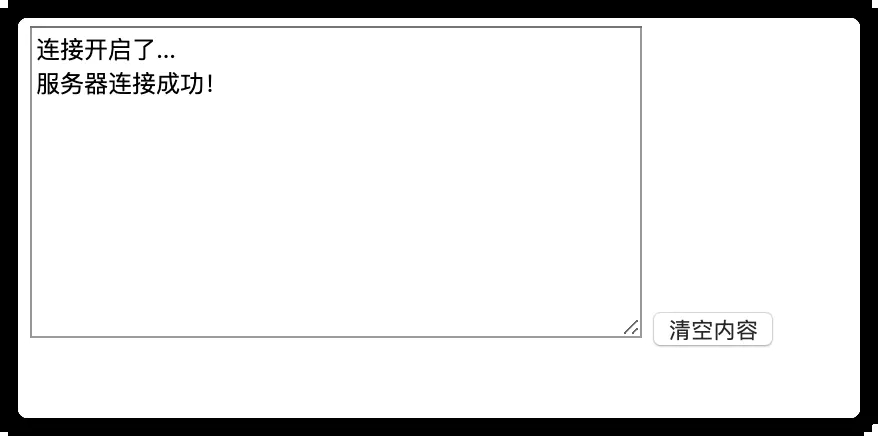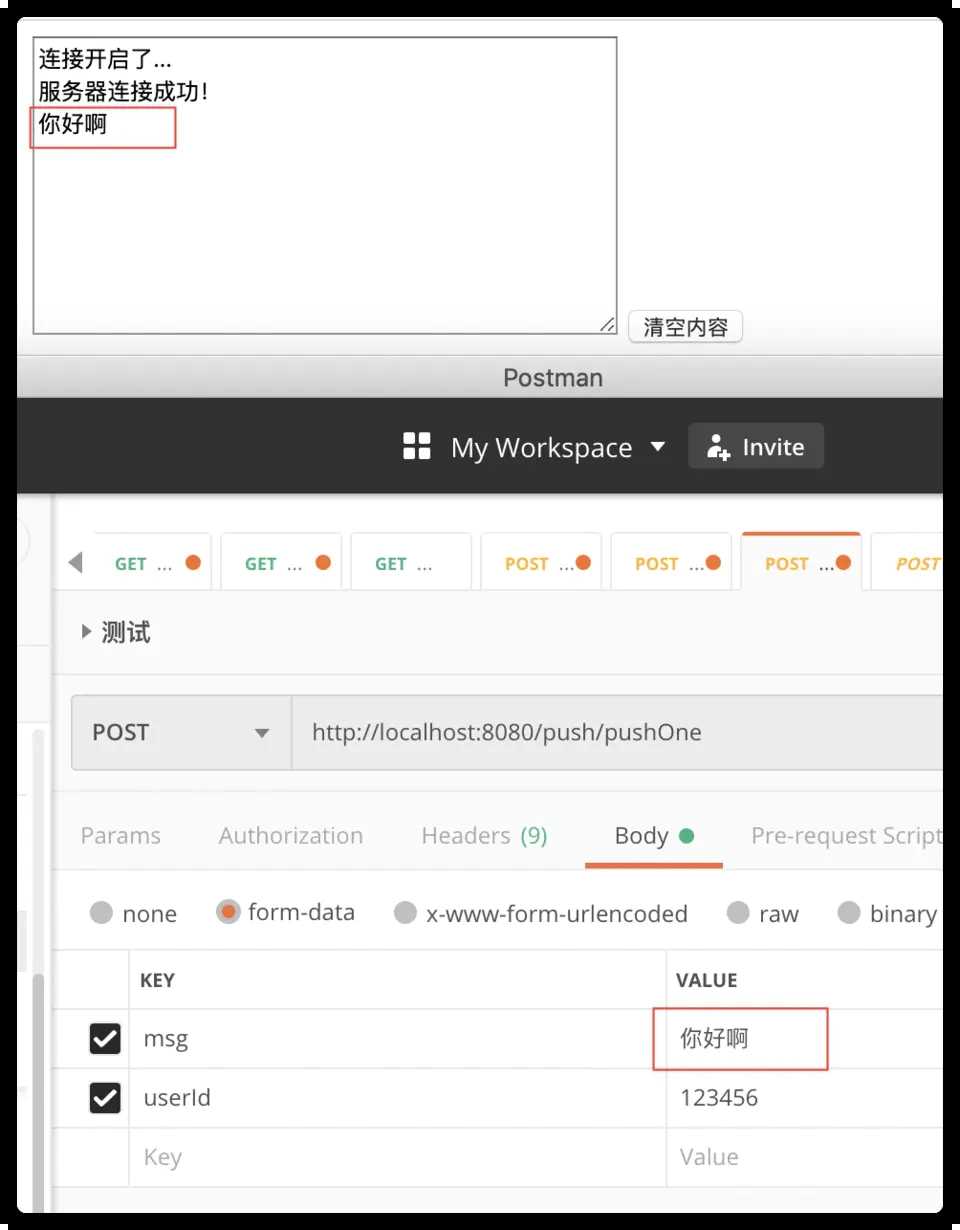这篇文章主要讲解了SpringBoot+WebSocket+Netty实现消息推送的方法,内容清晰明了,对此有兴趣的小伙伴可以学习一下,相信大家阅读完之后会有帮助。
大概实现思路:
下面是具体的代码实现,基本上每一步操作都配有注释说明,配合注释看应该还是比较容易理解的。
第零步:引入Netty的依赖,和一个工具包(只用到了json工具,可用其他json工具代替)
<dependency> <groupId>io.netty</groupId> <artifactId>netty-all</artifactId> <version>4.1.33.Final</version> </dependency> <dependency> <groupId>cn.hutool</groupId> <artifactId>hutool-all</artifactId> <version>5.2.3</version> </dependency>
第一步:在NettyConfig中定义一个channel组,管理所有的channel,再定义一个map,管理用户与channel的对应关系。
package com.sixj.nettypush.config;
import io.netty.channel.Channel;
import io.netty.channel.group.ChannelGroup;
import io.netty.channel.group.DefaultChannelGroup;
import io.netty.util.concurrent.GlobalEventExecutor;
import java.util.concurrent.ConcurrentHashMap;
/**
* @author sixiaojie
* @date 2020-03-28-15:07
*/
public class NettyConfig {
/**
* 定义一个channel组,管理所有的channel
* GlobalEventExecutor.INSTANCE 是全局的事件执行器,是一个单例
*/
private static ChannelGroup channelGroup = new DefaultChannelGroup(GlobalEventExecutor.INSTANCE);
/**
* 存放用户与Chanel的对应信息,用于给指定用户发送消息
*/
private static ConcurrentHashMap<String,Channel> userChannelMap = new ConcurrentHashMap<>();
private NettyConfig() {}
/**
* 获取channel组
* @return
*/
public static ChannelGroup getChannelGroup() {
return channelGroup;
}
/**
* 获取用户channel map
* @return
*/
public static ConcurrentHashMap<String,Channel> getUserChannelMap(){
return userChannelMap;
}
}第二步:创建NettyServer,定义两个EventLoopGroup,bossGroup辅助客户端的tcp连接请求, workGroup负责与客户端之前的读写操作,需要说明的是,需要开启一个新的线程来执行netty server,要不然会阻塞主线程,到时候就无法调用项目的其他controller接口了。
package com.sixj.nettypush.websocket;
import io.netty.bootstrap.ServerBootstrap;
import io.netty.channel.ChannelFuture;
import io.netty.channel.ChannelInitializer;
import io.netty.channel.EventLoopGroup;
import io.netty.channel.nio.NioEventLoopGroup;
import io.netty.channel.socket.SocketChannel;
import io.netty.channel.socket.nio.NioServerSocketChannel;
import io.netty.handler.codec.http.HttpObjectAggregator;
import io.netty.handler.codec.http.HttpServerCodec;
import io.netty.handler.codec.http.websocketx.WebSocketServerProtocolHandler;
import io.netty.handler.codec.serialization.ObjectEncoder;
import io.netty.handler.stream.ChunkedWriteHandler;
import org.slf4j.Logger;
import org.slf4j.LoggerFactory;
import org.springframework.beans.factory.annotation.Autowired;
import org.springframework.beans.factory.annotation.Value;
import org.springframework.stereotype.Component;
import javax.annotation.PostConstruct;
import javax.annotation.PreDestroy;
import java.net.InetSocketAddress;
/**
* @author sixiaojie
* @date 2020-03-28-13:44
*/
@Component
public class NettyServer{
private static final Logger log = LoggerFactory.getLogger(NettyServer.class);
/**
* webSocket协议名
*/
private static final String WEBSOCKET_PROTOCOL = "WebSocket";
/**
* 端口号
*/
@Value("${webSocket.netty.port:58080}")
private int port;
/**
* webSocket路径
*/
@Value("${webSocket.netty.path:/webSocket}")
private String webSocketPath;
@Autowired
private WebSocketHandler webSocketHandler;
private EventLoopGroup bossGroup;
private EventLoopGroup workGroup;
/**
* 启动
* @throws InterruptedException
*/
private void start() throws InterruptedException {
bossGroup = new NioEventLoopGroup();
workGroup = new NioEventLoopGroup();
ServerBootstrap bootstrap = new ServerBootstrap();
// bossGroup辅助客户端的tcp连接请求, workGroup负责与客户端之前的读写操作
bootstrap.group(bossGroup,workGroup);
// 设置NIO类型的channel
bootstrap.channel(NioServerSocketChannel.class);
// 设置监听端口
bootstrap.localAddress(new InetSocketAddress(port));
// 连接到达时会创建一个通道
bootstrap.childHandler(new ChannelInitializer<SocketChannel>() {
@Override
protected void initChannel(SocketChannel ch) throws Exception {
// 流水线管理通道中的处理程序(Handler),用来处理业务
// webSocket协议本身是基于http协议的,所以这边也要使用http编解码器
ch.pipeline().addLast(new HttpServerCodec());
ch.pipeline().addLast(new ObjectEncoder());
// 以块的方式来写的处理器
ch.pipeline().addLast(new ChunkedWriteHandler());
/*
说明:
1、http数据在传输过程中是分段的,HttpObjectAggregator可以将多个段聚合
2、这就是为什么,当浏览器发送大量数据时,就会发送多次http请求
*/
ch.pipeline().addLast(new HttpObjectAggregator(8192));
/*
说明:
1、对应webSocket,它的数据是以帧(frame)的形式传递
2、浏览器请求时 ws://localhost:58080/xxx 表示请求的uri
3、核心功能是将http协议升级为ws协议,保持长连接
*/
ch.pipeline().addLast(new WebSocketServerProtocolHandler(webSocketPath, WEBSOCKET_PROTOCOL, true, 65536 * 10));
// 自定义的handler,处理业务逻辑
ch.pipeline().addLast(webSocketHandler);
}
});
// 配置完成,开始绑定server,通过调用sync同步方法阻塞直到绑定成功
ChannelFuture channelFuture = bootstrap.bind().sync();
log.info("Server started and listen on:{}",channelFuture.channel().localAddress());
// 对关闭通道进行监听
channelFuture.channel().closeFuture().sync();
}
/**
* 释放资源
* @throws InterruptedException
*/
@PreDestroy
public void destroy() throws InterruptedException {
if(bossGroup != null){
bossGroup.shutdownGracefully().sync();
}
if(workGroup != null){
workGroup.shutdownGracefully().sync();
}
}
@PostConstruct()
public void init() {
//需要开启一个新的线程来执行netty server 服务器
new Thread(() -> {
try {
start();
} catch (InterruptedException e) {
e.printStackTrace();
}
}).start();
}
}第三步: 具体实现业务的WebSocketHandler,具体实现逻辑看注释
package com.sixj.nettypush.websocket;
import cn.hutool.json.JSONObject;
import cn.hutool.json.JSONUtil;
import com.sixj.nettypush.config.NettyConfig;
import io.netty.channel.ChannelHandler;
import io.netty.channel.ChannelHandlerContext;
import io.netty.channel.SimpleChannelInboundHandler;
import io.netty.handler.codec.http.websocketx.TextWebSocketFrame;
import io.netty.util.AttributeKey;
import org.slf4j.Logger;
import org.slf4j.LoggerFactory;
import org.springframework.stereotype.Component;
/**
* TextWebSocketFrame类型, 表示一个文本帧
* @author sixiaojie
* @date 2020-03-28-13:47
*/
@Component
@ChannelHandler.Sharable
public class WebSocketHandler extends SimpleChannelInboundHandler<TextWebSocketFrame> {
private static final Logger log = LoggerFactory.getLogger(NettyServer.class);
/**
* 一旦连接,第一个被执行
* @param ctx
* @throws Exception
*/
@Override
public void handlerAdded(ChannelHandlerContext ctx) throws Exception {
log.info("handlerAdded 被调用"+ctx.channel().id().asLongText());
// 添加到channelGroup 通道组
NettyConfig.getChannelGroup().add(ctx.channel());
}
/**
* 读取数据
*/
@Override
protected void channelRead0(ChannelHandlerContext ctx, TextWebSocketFrame msg) throws Exception {
log.info("服务器收到消息:{}",msg.text());
// 获取用户ID,关联channel
JSONObject jsonObject = JSONUtil.parseObj(msg.text());
String uid = jsonObject.getStr("uid");
NettyConfig.getUserChannelMap().put(uid,ctx.channel());
// 将用户ID作为自定义属性加入到channel中,方便随时channel中获取用户ID
AttributeKey<String> key = AttributeKey.valueOf("userId");
ctx.channel().attr(key).setIfAbsent(uid);
// 回复消息
ctx.channel().writeAndFlush(new TextWebSocketFrame("服务器连接成功!"));
}
@Override
public void handlerRemoved(ChannelHandlerContext ctx) throws Exception {
log.info("handlerRemoved 被调用"+ctx.channel().id().asLongText());
// 删除通道
NettyConfig.getChannelGroup().remove(ctx.channel());
removeUserId(ctx);
}
@Override
public void exceptionCaught(ChannelHandlerContext ctx, Throwable cause) throws Exception {
log.info("异常:{}",cause.getMessage());
// 删除通道
NettyConfig.getChannelGroup().remove(ctx.channel());
removeUserId(ctx);
ctx.close();
}
/**
* 删除用户与channel的对应关系
* @param ctx
*/
private void removeUserId(ChannelHandlerContext ctx){
AttributeKey<String> key = AttributeKey.valueOf("userId");
String userId = ctx.channel().attr(key).get();
NettyConfig.getUserChannelMap().remove(userId);
}
}
**第四步:**具体消息推送的接口
public interface PushService {
/**
* 推送给指定用户
* @param userId
* @param msg
*/
void pushMsgToOne(String userId,String msg);
/**
* 推送给所有用户
* @param msg
*/
void pushMsgToAll(String msg);
}接口实现类:
import java.util.concurrent.ConcurrentHashMap;
/**
* @author sixiaojie
* @date 2020-03-30-20:10
*/
@Service
public class PushServiceImpl implements PushService {
@Override
public void pushMsgToOne(String userId, String msg){
ConcurrentHashMap<String, Channel> userChannelMap = NettyConfig.getUserChannelMap();
Channel channel = userChannelMap.get(userId);
channel.writeAndFlush(new TextWebSocketFrame(msg));
}
@Override
public void pushMsgToAll(String msg){
NettyConfig.getChannelGroup().writeAndFlush(new TextWebSocketFrame(msg));
}
}controller:
package com.sixj.nettypush.controller;
import com.sixj.nettypush.service.PushService;
import org.springframework.beans.factory.annotation.Autowired;
import org.springframework.web.bind.annotation.PostMapping;
import org.springframework.web.bind.annotation.RequestMapping;
import org.springframework.web.bind.annotation.RequestParam;
import org.springframework.web.bind.annotation.RestController;
/**
* @author sixiaojie
* @date 2020-03-30-20:08
*/
@RestController
@RequestMapping("/push")
public class PushController {
@Autowired
private PushService pushService;
/**
* 推送给所有用户
* @param msg
*/
@PostMapping("/pushAll")
public void pushToAll(@RequestParam("msg") String msg){
pushService.pushMsgToAll(msg);
}
/**
* 推送给指定用户
* @param userId
* @param msg
*/
@PostMapping("/pushOne")
public void pushMsgToOne(@RequestParam("userId") String userId,@RequestParam("msg") String msg){
pushService.pushMsgToOne(userId,msg);
}
}第五步:前端html页面
<!DOCTYPE html>
<html lang="en">
<head>
<meta charset="UTF-8">
<title>Title</title>
</head>
<body>
<script>
var socket;
// 判断当前浏览器是否支持webSocket
if(window.WebSocket){
socket = new WebSocket("ws://192.168.174.25:58080/webSocket")
// 相当于channel的read事件,ev 收到服务器回送的消息
socket.onmessage = function (ev) {
var rt = document.getElementById("responseText");
rt.value = rt.value + "\n" + ev.data;
}
// 相当于连接开启
socket.onopen = function (ev) {
var rt = document.getElementById("responseText");
rt.value = "连接开启了..."
socket.send(
JSON.stringify({
// 连接成功将,用户ID传给服务端
uid: "123456"
})
);
}
// 相当于连接关闭
socket.onclose = function (ev) {
var rt = document.getElementById("responseText");
rt.value = rt.value + "\n" + "连接关闭了...";
}
}else{
alert("当前浏览器不支持webSocket")
}
</script>
<form onsubmit="return false">
<textarea id="responseText" ></textarea>
<input type="button" value="清空内容" onclick="document.getElementById('responseText').value=''">
</form>
</body>
</html>目前为止,所有代码已经写完了,测试一下
首先运行这个html文件,会看到服务端给前端返回的消息“服务器连接成功了!”,后端日志会打印服务器收到消息:{"uid":"123456"}

然后使用postman测试推送的接口

测试成功,打完收工
看完上述内容,是不是对SpringBoot+WebSocket+Netty实现消息推送的方法有进一步的了解,如果还想学习更多内容,欢迎关注亿速云行业资讯频道。
免责声明:本站发布的内容(图片、视频和文字)以原创、转载和分享为主,文章观点不代表本网站立场,如果涉及侵权请联系站长邮箱:is@yisu.com进行举报,并提供相关证据,一经查实,将立刻删除涉嫌侵权内容。